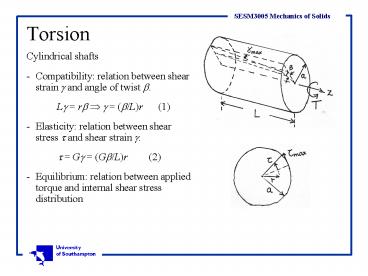Torsion - PowerPoint PPT Presentation
1 / 16
Title:
Torsion
Description:
Cylindrical shafts. Compatibility: relation between shear strain g and angle of twist b. ... acting on sub-section i. Since twist of all sub-sections is the ... – PowerPoint PPT presentation
Number of Views:2304
Avg rating:3.0/5.0
Title: Torsion
1
Torsion
- Cylindrical shafts
- Compatibility relation between shear strain g
and angle of twist b. - Lg rb ? g (b/L)r (1)
- Elasticity relation between shear stress t and
shear strain g. - t Gg (Gb/L)r (2)
- Equilibrium relation between applied torque and
internal shear stress distribution
2
Torsion
- Internal shear stress distribution is equivalent
to the torque
where J is the torsion constant (equal to the
polar moment of area in this special case)
- Eliminating b between Eq. (2) and Eq. (3)
- Strength constant
3
Torsion
- Bars with non-circular cross section
- z axis of twist
- q angle of twist per unit length
- b qz
- Displacement components
- u qyz, v qxz, w qy(x,y)
- y(x,y) warping function
4
Torsion
Shear strain
Solution for stress Compatibility equation
Equilibrium equation
Prandtls stress function f
Equilibrium equation identically satisfied while
compatibility equation becomes
5
Torsion
- Boundary condition no traction on lateral
surface S - sPz szx cosg szy sing 0 on S
- This leads to
- f 0 on S
- Torque
With the stresses found as functions of x, y and
q, the above integral is reduced to the form
Thus the integration of r.h.s. of (4) produces
the torsional constant J.
6
TorsionSolutions for the stress function
- Elliptical section
- Assumed solution
- This satisfies the boundary condition. It also
satisfies the differential equation if B is given
by
- Stresses
7
TorsionSolutions for the stress function
- Elliptical section
- Maximum shear stress
- Torsional constant
- Strength constant (defined through T Ctmax)
8
TorsionSolutions for the stress function
- Equilateral triangle section
- Assumed solution
- This satisfies the boundary condition. It also
satisfies the differential equation if B is given
by
- Maximum shear stress
- Torsion constant
- Strength constant
9
Torsion Rectangular section
- Series solution for the stresses valid for b ? h
leads to - tmax szy( h,0) k3(2h)Gq (5)
- With only the first term in the series retained
- Substituting the stresses into the integral
giving the torque
10
Torsion Rectangular section
- Again, sufficient accuracy is achieved by
retaining the first term in the series (n 0) - T ? k1 (2b)(2h)3Gq (6)
where
- From (5) and (6)
- T ? k2 (2b)(2h)2 tmax, k2 k1/k3
- ? Torsional constant J k1 (2b)(2h)3
- Strength constant C k2 (2b)(2h)2
11
Torsion composite section
- The section is divided into N sub-sections of
known torsional properties. - Total torque
where Ti is the torque acting on sub-section i.
Since twist of all sub-sections is the same,
- Section made up of rectangular sections
- Ti Ci (tmax)I
- Hence
12
Torsion composite section examples
- Open channel section (all dimensions in mm)
- Find tmax due to T 600 Nm
- 2h1 9, 2b1 100
- 2h2 5, 2b2 182
- 2h3 9, 2b3 100
- Since bi/hi gt 10 for all i
- k1 ? k2 ? 0.333, k3 ? 1
where ? tmax 96.11 MPa
13
Torsion composite section examples
- Open I-section (all dimensions in mm)
- Determine T for an allowable shear stress of 240
MPa and a safety factor of 3 - 2h1 2h2 2h3 2h 6,
- 2b1 2b3 100, 2b2 138
- bi/hi gt 10 for all i
- k1 ? k2 ? 0.333, k3 ? 1
where
? T 324.5 Nm
14
Torsion closed thin-wall section
- Relative to a curvilinear frame of reference s-n
- szn ? 0, szs t(s)
- Equilibrium in z direction gives
- Shear flow q(s) t(s) t(s) constant.
- Torque
- where A is the area enclosed by the centreline
l. - Strain energy must be equal to the work done by
the torque
Substituting from (Eq. 7) to Eq. (8)
15
Torsion closed section with internal walls
- Section considered as an assembly of N tubular
sub-sections (compartments), each subjected to
torque Ti. - Total torque
Compartment i
Common twist for all compartments
where q? is the shear flow due to torque in
adjacent compartments.
16
Torsion closed section with internal walls
- Example 6.6
- Determine maximum torque for an allowable shear
stress of 40 MPa. - G 26 GPa
T T1 T2 2A1q1 2A2q2 A1 (60?103)2, A2
0.5p(30?103)2
- ? q1 / q2 1.22 BUT t1 / t2 1.5
- Therefore maximum shear develops in l2
- q2 t2tmax 120?103, q1 1.22 q2 ? max T
- For the wall with t3 1.5, check that (q1
q2)/1.5 lt tmax

